#Sidebands
Explore tagged Tumblr posts
Text
Ham Radio: A Personal Account
by Kevin Gillette
Amateur radio, or ham radio as it is more commonly known, has been a hobby for millions of people around the world for approximately 100 years, give or take. It exists today for much the same reason it came about in the first place: it is (and was) a way for both amateur and professional engineers, tinkerers, physicists and inventors to interact with one another, comparing notes, ideas and innovations that have played a major role in the expansion of telecommunications up to the present day.
This brief memoir is not a history of the hobby, for I came into it only 50 years ago, in 1974. As a result, I don’t have first-hand knowledge of most of what came before. But I can sketch the essentials for you, and with any luck, I will persuade you to see how this hobby can bring a great deal of joy and satisfaction. At the end of this account I will provide some tangible evidence of my days at the helm of a transmitter/receiver/antenna combination over the course of several decades.
First, some preliminaries:
Ham radio began about 100 years ago. The very first enthusiasts used very primitive equipment for both transmission and reception. The earliest transmitters used a technique called spark gap in which the radio signal arose from a spark generated between two electrodes. The frequency of this transmission was dictated by the physics of the electrodes and the gap between them.
For frequency, think of your standard AM and FM broadcast bands, or local television. Radio emission occurs when an electrical field rapidly reverses direction – that is, electrons flow back and forth through a wire or some other device capable of supporting an electromagnetic field. The speed with which this flow of electrons reverses course determines the frequency; the faster the course reversal, the higher the frequency. A single round trip of the electrons is usually referred to as a cycle. Thus, frequency is expressed in cycles per second, or in an equivalent unit, Hertz (one Hertz = one cycle per second). All electromagnetic radiation can be expressed this way. Radiation typically occurs when the flow of electrons alternates direction - electron flow goes by the term current, and so radiation happens with alternating current, or AC. In many (though not all) countries, the electricity that comes out of a wall plug is AC. The opposite of AC is DC - direct current - and this is the case when the electrons always flow the same direction. In essence, DC is zero Hertz AC.
The range of hearing of most humans is between about 60 Hertz (Hz) and roughly 10,000 Hz (this is also indicated as 10 kiloHertz, or 10 KHz). In the United States, the AM broadcast band is from 540 KHz to 1600 KHz (this latter measurement is also expressed as 1.6 megaHertz, or 1.6 MHz). Standard television signals have traditionally begun at 54 MHz, which each television channel occupying a total of 6 MHz. So this means that Channel 2 (for obscure reasons, there is no Channel 1) is from 54 – 60 MHz, channel 3 from 60 – 66 MHz, and so on. There is a break in this pattern for the U.S. FM broadcast band, which lives from 88.0 – 108.0 MHz; the TV channels then continue up to channel 13. The channels 2 through 13 are called the VHF - Very High Frequency - channels. After channel 13 there is another significant frequency gap, after which the UHF, or Ultra High Frequency channels begin, with channel 14.
I’ve mentioned a couple of undefined terms: AM and FM. AM stands for Amplitude Modulation. This was the earliest method used for transmitting sound signals (voice, music, etc). It works by using a central frequency known as the carrier and superimposing an audio frequency on it, resulting in the actual size of the emission varying (at the carrier frequency) according to the audio frequency. This methodology gives rise to what are called sidebands, which cover the frequencies between the carrier frequency plus and minus the audio frequency. This is still used today on the AM broadcast bands in most countries. It is rather wasteful in terms of power, since a lot of the transmitted signal power is in the carrier itself rather than the sidebands where all the good stuff is. For this reason, ham radio operators who do voice transmissions have, since about the 1940s or so, used something called SSB, or single sideband transmission. In this mode, one chooses one of the two sidebands (lower or upper) and suppresses the other one as well as the carrier, meaning that most of the transmitted power goes into the information in the signal rather than being wasted. A more recent form of transmission is FM - Frequency Modulation. In FM transmission, instead of varying the amplitude of the carrier wave as a function of the audio content, the frequency wiggles according to the superimposed audio content. In AM transmission, static and other interference phenomena tend to occur at the peaks of the modulation waveform (see the figure below); with FM, the peaks of the waveform don’t contain information so they can be filtered out, and this gives rise to the notion - largely true - that FM is static-free. Here is an example AM waveform as seen on an oscilloscope:
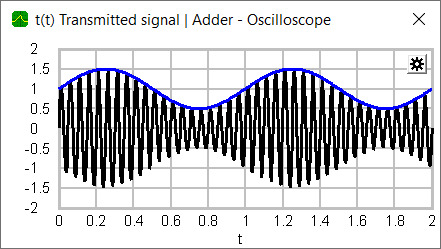
For comparison, here is an example of an FM waveform as seen on an oscilloscope:

In this latter picture, notice how the amplitude of the waveform doesn’t change, but the spacing between the cycles does – this is the wiggle in the frequency I referred to earlier.
I mentioned voice operations in ham radio using a technique called SSB. There are other techniques, especially at the higher frequencies, but I’m not going into those here. I admit that I am something of a purist; I have always preferred to use Morse Code in my ham radio exploits. This is known as CW - Continuous Wave - in the ham radio community. The idea is that to transmit Morse Code, one merely turns a carrier – a continuous wave – on and off with a Morse Code key or something equivalent to it. Speed of transmission is usually expressed in words per minute - wpm. Although the requirement is gone today, in the past, obtaining a ham radio license required the operator to demonstrate at least a basic proficiency in Morse Code, usually somewhere between 5 and 20 wpm. A word in this context is a group of 5 characters and the space after them. I’m proud to say that at my peak, I could listen to – “copy” – transmissions running at about 45 wpm. The world record in those days was somewhere in the neighborhood of 75 wpm, and high-speed code operators in the US Navy and elsewhere typically operated at around 50 wpm, so I was competitive in the CW community as far as speed.
I’ve talked a lot about transmission, but of course it’s all for naught if there’s no way to hear the signal. To do this, one needs a receiver. Receivers are generally much more complicated devices than transmitters – even a modern transmitter can often be constructed with perhaps a dozen discrete parts, including the power supply (or batteries), whereas modern receivers typically need about 10 times that amount in order to be effective and reliable. This is because transmitting is essentially an increasing entropy operation from a thermodynamic perspective, whereas receiving is a decreasing entropy operation, which fights against the tendency toward greater entropy according to the 3rd Law of Thermodynamics. This is much the same as it being a lot easier to generate heat than to remove it from an environment. Receivers are far too complicated to get into here, but I will note that for the kind of work I did – CW and Morse Code – the way the signal could be heard was to tune the receiver to a frequency just slightly to one side of the transmitting carrier frequency and use what’s called a BFO - Beat Frequency Oscillator - to provide a sidetone that represents the difference between the BFO frequency and the carrier frequency. This will be important a bit later, so remember that term.
And of course the ensemble isn’t complete without some kind of antenna. Like both transmitters and receivers, antennas can be everything from a simple piece of wire to a very elaborate contraption that covers a lot of real estate. The rule of thumb is that the higher the frequency, the smaller the antenna needs to be. A very common kind of antenna used on the lower ham radio bands is a vertical antenna, which as the name implies, is a piece of metal (usually aluminum) that is vertically installed. The cable that connects the antenna to the transmitter and receiver is usually attached at the bottom of such an antenna – a picture of such an arrangement appears below:
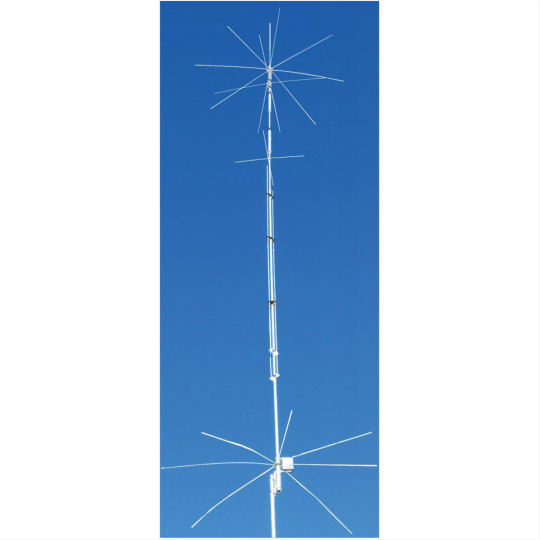
In this photograph, the antenna has some extra horizontal spokes coming off of it at various points – these are used to suppress capacitance effects of the central pole (the fact that it’s a hollow tube and not an infinitely thin wire causes some of these issues to arise) and to otherwise improve the performance of the antenna.
I haven’t said much about power, so I’ll do so now. Where commercial broadcast stations can transmit at quite high power – varying from 1000 watts to upwards of 100,000 watts – ham radio is restricted to a maximum of 1000 watts for CW and 2000 watts for SSB. I was typically a low-power operator, seldom going above 50 watts and often no more than 10 watts. And yet I was able to make contact with people all over the world on such modest power, so it doesn’t take a lot. An effective antenna system and favorable geography are the primary arbiters of how well one can communicate over long distances.
Something else I mentioned but haven’t yet elaborated on is the licensing process. In the United States, there used to be the following levels of licensing, from the most basic to the most advanced: Novice, Technician, General, Advanced, Extra. I began my ham radio career as a Novice, as everyone did in those days. My radio call sign was WN6FEB (see photo below). To obtain a Novice license, one had to know some basic electronic and radio theory, some basic regulatory stuff (power, bands, on-air protocols, etc) and have mastered Morse Code at 5 wpm. I obtained this license when I was 13 years old. A short time later I upgraded to a General class license and a slightly new call sign, WA6FEB, which extended the radio frequency bands I was permitted to operate on and also extended my maximum output power (as a Novice I was restricted to 100 watts, I think). The General class license required knowledge of more advanced electronics and radio physics, a bit more regulations and Morse Code proficiency of 13 wpm. A few years later I took the plunge and got my Extra class license, which expanded the knowledge base from the previous two licenses and required Morse speed of 20 wpm. As an Extra class ham, I had unlimited access to all internationally agreed-upon ham frequency bands and full power rating. My main motivation in getting the Extra class license was the radio bands – I was never a high-power operator.
My Novice license QSL card (more on this in a moment):
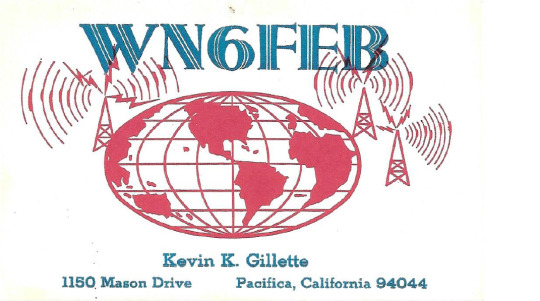
My Extra class license QSL card:
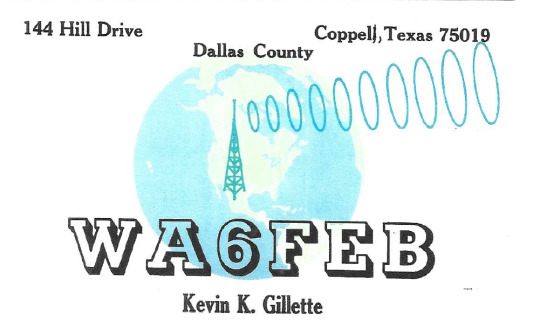
QSL cards are like postcards for hams – we often exchange them to acknowledge that we’ve made contact. They’re often attractive and make great wallpaper or collectibles. I’ve amassed quite a few over the years – there are examples of QSL cards received from around the world at the bottom of this article.
Dovetailing with a previous paragraph, a few words about ham radio frequency bands. Per international agreement, ham radio operators have a large number of radio spectrum segments allocated for their use. It should be noted that in many cases, these allocations are not exclusively for ham radio. One example is the 40-meter band, which covers 7.0 – 7.3 MHz. At least in the 1970s and 1980s, this band featured a lot of non-ham activity, including over-the-horizon radar from the USSR and Voice of America broadcasts from various parts of the world. What made this especially annoying is that the 40-meter band was almost universally open, meaning that effective communication could happen on that band at any time of the day or night, year-round. The Soviet radar sounded like a very loud metronome, and Voice of America was an AM transmission in a segment of the radio spectrum where people didn’t normally use AM, meaning that receivers tuned to this part of the spectrum ended up hearing the carrier as well as the audio signal (which made the audio portion hard to understand). Still, for a young ham radio aficionado hunting for exotic call signs in the ether, it was a lot of fun to wade among the incoherent mass of radio transmissions.
The bands are usually referred to by their approximate wavelength. Recalling that light travels at approximately 300,000,00 meters/second, here is a sample of some of the bands that were popular when I first started back in 1974 (there have been additional bands added to the spectrum since that time; I have no experience on those bands):
HF:
160 meters – 1.8 – 2.0 MHz (I didn’t have any contacts on this band, but my older receiver permitted me to listen in. The antenna requirements for this band are too large for the real estate I had.)
80 meters – 3.5 – 4.0 MHz
40 meters – 7.0 – 7.3 MHz
20 meters – 14.0 – 14.35 MHz
15 meters – 21.0 – 21.45 MHz
10 meters – 28.0 – 29.7 MHz
VHF:
6 meters – 50.0 – 54.0 MHz (note that this is just below the start of the standard television broadcast segment, Channel 2, as noted earlier)
2 meters – 144.0 – 148.0 MHz
I also mentioned the idea of a band being open. On the HF (High Frequency) bands, the propagation of a signal often proceeds in two ways: ground wave and sky wave. Ground wave is exactly as the name implies; the radio signal follows the ground. This signal is of comparatively short distance, perhaps 100 miles or thereabouts. Sky wave is quite a different phenomenon and involves the signal bouncing off of the ionosphere, a layer of our atmosphere that lives between 50 and 600 miles above the Earth’s surface. As the name suggests, this layer contains a lot of ionized particles - mostly from the Sun’s interaction - and it is this layer of ions that forms a sort of reflecting barrier for radio waves below a certain frequency. The highest frequency for which the ionosphere is a reflecting barrier is referred to as the MUF - Maximum Usable Frequency. Above this frequency, radio transmissions pass through the ionosphere and out into space. When a band is open, that means that the MUF is greater than the band’s frequency, at least as an approximation. The 40-meter band is virtually always below the MUF, meaning that it’s open all of the time. This is what makes it so popular. The 20-meter band is often (though not always) open, which is what makes it a premium band for long distance communications, referred to in ham radio parlance as DX (which stands for distance). The 20-meter band has the advantage that it is strictly for ham radio – no competing services cause interference and noise. When an HF band is open, the sky wave mode of signal propagation is also referred to as skip, meaning that the signal will skip off of the ionosphere, sometimes multiple times – this makes for worldwide transmission and reception.
You may be asking yourself what was in it for me, that I would have such fervor for a hobby that is admittedly declining in popularity (with the advent of email and the Internet). I think a simple anecdote will make it clear:
When I was about 15 years old, early in my ham radio career, I lived in a small town near San Francisco and also near Stanford University. I had an on-air friend named David Gray, WB6ZMJ, who was a graduate student in geophysics at Stanford. David was a member of the Stanford Amateur Radio Club (SARC):
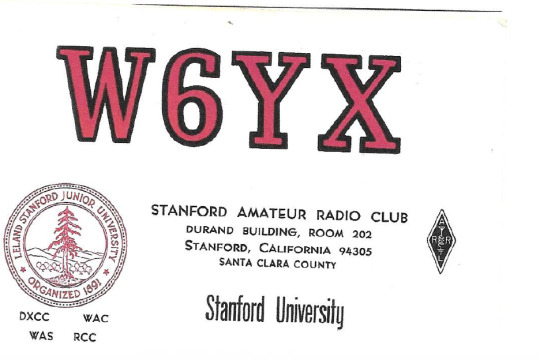
One weekend he invited me down to Stanford to participate in what is known as moonbounce. In moonbounce, hams from across the globe will transmit on the VHF frequencies directly up to the Moon, bouncing their signal off the Moon to be received somewhere else on the planet. Recall what I mentioned above about the MUF; the VHF frequencies are all well above the MUF, so VHF signals cannot participate in the skip mode of propagation (except under some very unusual circumstances). Stanford University has an enormous radio telescope, affectionately referred to as The Dish, that sits on a small hill on the SW side of campus. A picture of it appears below. The Dish is about 150 feet across and was built in 1961. It remains in use to this day. The SARC used The Dish as their antenna for moonbounce activity.
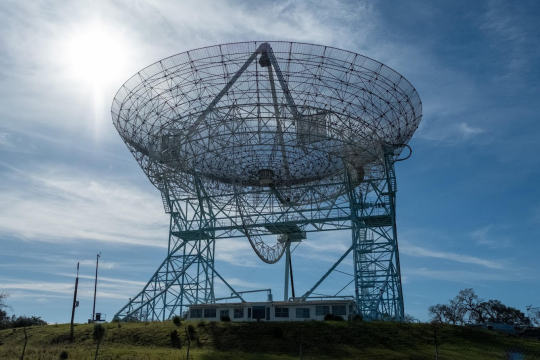
Here's the rub: The path length from Earth – Moon – Earth (EME) is about 500,000 miles. The loss in signal strength approaches 250 dB, which equates to dropping from a Formula 1 roar down to the tiniest of whispers. In fact, the signal strength is so low that even when using CW, the signal isn’t strong enough to trigger a BFO for a sidetone in order to read the signal. The only way to hear the signal is to listen for quiet spots in the background noise! That’s where I came in on this particular occasion. I have (and have always had) exceptionally acute high-frequency hearing, and so what sounded like white noise to the grad students in the SARC was an intelligible signal to me. So, in the middle of the night, there I was, in the metal housing seen at the base of The Dish, listening to a mysterious CW signal from a ham in Sweden coming by way of deep space, and writing down what I heard. For a lonely, nerdy kid, this was the height of affirmation – it was OK to be nerdy and science-oriented when you got to play with such exotic toys! Indeed, not only did this experience cement my desire to pursue ham radio; it also confirmed that Stanford was the place I wanted to pursue my university studies (as indeed I did, graduating with a Bachelor’s degree in applied mathematics and a Master’s degree in operations research, all before my 21st birthday).
In the years following graduation from Stanford, I got married and moved to Dallas, Texas, where once we purchased our first home, I immediately set up a nice ham shack in the laundry room. I made tons of great contacts all over the world with the most modest of equipment (alas, I don’t have any photos of my gear from those days). When we started our family, the hobby had to take a back seat, and eventually I let my license lapse. But now that I am approaching retirement age, I long once more to get back on the air and hunt for those mysterious signals beaming in from everywhere.
Kevin Gillette, 26 January 2024
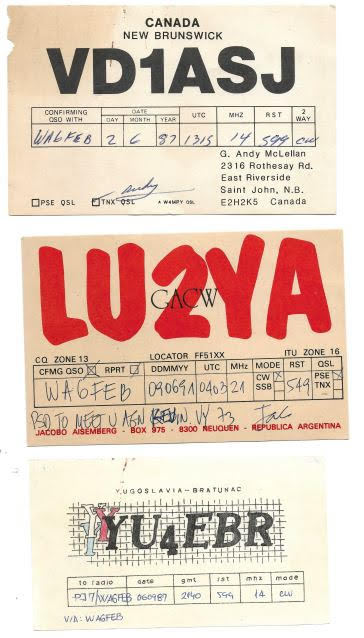
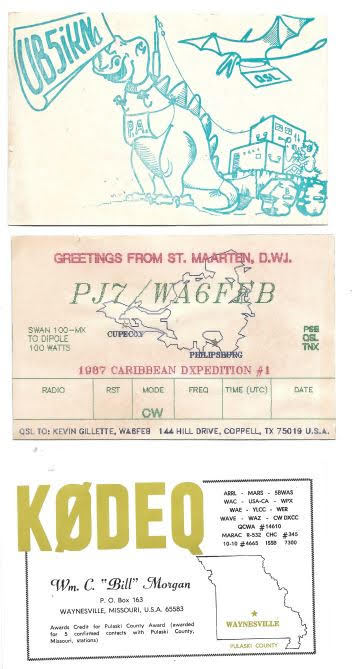



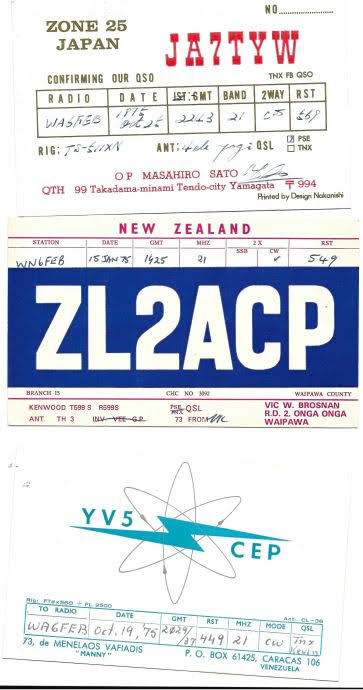
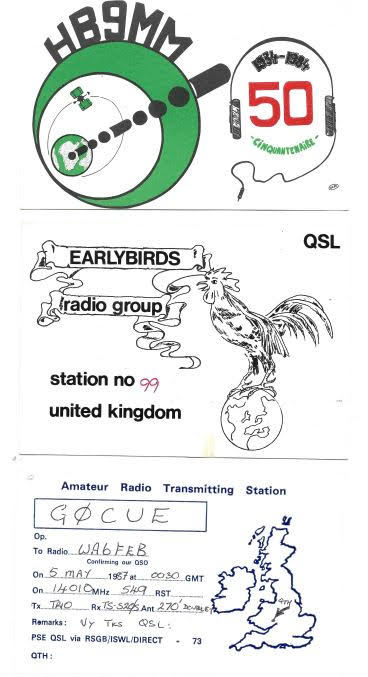
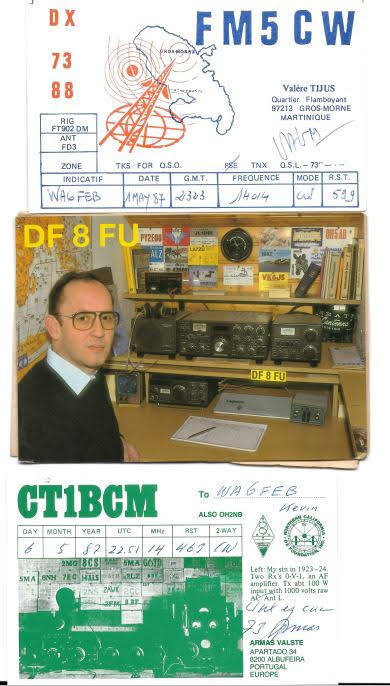


Image credits : Images in the text with thanks to © respective creators and publishers. QSL Cards at end of article above received by author, with thanks to © respective creators
Kevin Gillette
Words Across Time
26 January 2024
wordsacrosstime
#Words Across Time#Kevin Gillette#wordsacrosstime#January 2024#Amateur Radio#Ham Radio#Broadcast Bands#Electromagnetic Field#Stanford Amateur Radio Club#Beat Frequency Oscillator#US Navy#Morse Code#SSB#AM#FM#Maximum Usable Frequency#Sidetone#Sidebands#Continuous Wave#Antenna#Spark Gap#Hobby#Tinkerers#Inventors#Telecommunications#VHF#Frequency Modulation#Amplitude Modulation#Alternating Current#Direct Current
1 note
·
View note
Photo





Pacific sideband, Monadenia fidelis, Xanthonychidae
Photographed in British Columbia by thomasbarbin
2K notes
·
View notes
Text

Invertober Day 14: redwood sideband snail
#art#illustration#animals#bugs#invertebrates#mollusks#snails#redwood sideband snail#nature#artists on tumblr#invertober#invertober2024
124 notes
·
View notes
Text

Detritivores
#banana slug#slug#snail#pacific sideband snail#bug#bugs#animals#wildlife#animal#forest#nature#beauty#photographers on tumblr#artists on tumblr#original photographers#original photography#photography#aesthetic#Washington#pnw#westcoastbestcoast#art#vsco#pacific northwest#explore#travel#cottagecore#p
137 notes
·
View notes
Text

Invertober 14, Redwood Sideband Snail
#digital art#procreate#bright colours#invertober#invertober2024#invertebrates#Gastropod#Snail#Redwood Sideband snail#Snail art
113 notes
·
View notes
Text

25 notes
·
View notes
Text


What pretty shells. Who do they belong to? Pacific sideband snails (Monadenia fidelis), which are native to the Pacific Northwest.
16 notes
·
View notes
Text






Met a cute guy today 😳
3 notes
·
View notes
Text

The Voidz at the Great American Music Hall, photographed by Grant Kerber, June 2023
#FINE. ill post other sidebands besides little joy whateverrrrrrr /j#alternative music#the voidz#the strokes#thestrokeseveryday#julian casablancas#electronic music#indie music
21 notes
·
View notes
Text

Characters: Corey Riffin X Vana Glama
Fandoms: Grojband | Sidekick
Relationship: Romantic
Submitted by @coreyriffinbeastxmode
Another good looking pair!
#crossover ship#grojband#sidekick#sideband#grojkick#corey riffin#vana glama#covana#f/m#romantic ship
14 notes
·
View notes
Text

Transformers OC !!!!
This is Sideband, he’s a little bitch <3 He’s a minibot + his alt form is a ham radio
I created him a while back bc my friend has this whole transformers au going + finally made him some nice digital art today
#my art#digital art#ocs#sideband#transformers#transformers au#minibot#transformers oc#tf oc#mtmte oc#idw mtmte#mech
7 notes
·
View notes
Text

Pacific Sideband (Monadenia fidelis)
#lensblr#invertebrates#snails#pacific sideband#reddish guy i ever saw. was fascinated by his beauty#i dont feel a picture does him justice...
1 note
·
View note
Text

0 notes
Text

invertober day 14, redwood sideband snail. \o/
574 notes
·
View notes
Text

Collection tin from Green Mountain Wildcat trail: false morel, hemlock cone, madrone skin miner leaf, flower thing, map fungus leaf | squirrel skull, pacific sideband snail shell, red belt conk, feather, cool rock.
#artists on tumblr#original photographers#original photography#hiking#pacific northwest#nature#washington#pnw#nikon#orofeaiel#mushrooms#mycology#collection tin#found objects#found items#forest finds#tiny treasures#seen in my walk#keepsakes#vulture culture
599 notes
·
View notes
Text


Sort of! The mortise is a device partially devised by my creator.
The etymology is quite fascinating, I think! A mortise is traditionally one half of a very simple carpentry junction, yes. Its shape does not dictate what material is needed to interface, only that the complementary half be the appropriate positive space.
This is a term used among palagrins to...
...describe most communication devices of its nature. In a similar way, I understand that you all use the term "computer" to describe a vast array of different concepts (even applied to ones of your own species, historically)! We, too, have devices which are best translated as being computers, but a mortise is a more specific designation.
The mortise I hold here is of special make, and it is the device through which you and I are able to speak so easily! The exact nature of what makes it unique, though, is best described by Silted Frost himself. I've offered to transcribe as he speaks:
Please accept my benevolence and most sincere apologies for having enjoyed these Delays to sharing with you our first Cross communication. Near Water and Ragged Breath has novelly delivered to you my name, though I reiterate: I am Silted Frost, Nine Ruby Droplets, Former Architect and Wind Villa Vagabond.
This device became functional only unexpectedly, whilst my companion quibbled with it over the snow. I cannot...
He has actually been pacing for some time now. I transcribed exactly as those words were delivered. Though, he seems ready to continue:
I cannot lay out for you the mix of emotions I feel in speaking to an audience which is not Near Water.
Right, yes. My device is uniquely capable of long-distance communication via three-and-twenty basic particles. Energy from void rarefaction is concentrated and directed to selectively adjust Bloch vectors in such a way that creates an entanglement, ideally with a targeted set of particles some space away. It was found that a temporally-dense enough pulse of energy can be used to tweak various properties of these particles via dipolar coupling and resolved-sideband laser cooling. I sit within the yoke of my ancestors for this to be possible, though, as void-technology is the only methodology which has made such precision instruments, such as cooling past zero-point, Possible.
The inevitable barrier I'd encountered was the realization that, due to the nature of entanglement, no three-and-twenty particles could be targeted with any level of selectiveness. To say "targeted" even was simply inaccurate. The mortise would have to be cycled until some set of particles was snagged that showed some promise of some redundancy and patterning. The Cycles drained while it searched were, in hindsight, a substantive resource failure.
I admit, though, that you were not my goal. Your species is both far and flawed, and in many ways incapable of internalizing what I intended to ask of this mortise's counterpart. Learning more about your world has been myself and Near Water and Ragged Breath's sole focus for Three Cycles now, and many paths have opened. Many more have closed, in a way, but this is to be expected. It is a joy to know that this mortise were feasible, were Possible. Odd as it is.
I look forward to more Cross with you, truly! Though it was with some pain I had peeled myself from my study to speak. My partner's eagerness to talk indeed surpasses my own, at least in the meantime. I prefer to know all and what else, as much as I can, before communicating. You will hear more of me in time.
Not much I can add, I think! Thank you for your inquiry, as always. Pleasant Cycles. 💛
84 notes
·
View notes